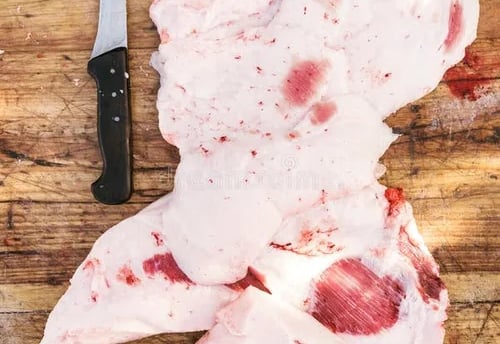Rendering Animal Fat
A Guide to Purifying and Storing at Home
FOOD STORAGEFOODMEAT & DAIRY
By: Stephanie
12/12/20232 min read


Introduction
As you embark on the process of butchering your poultry and livestock, it is crucial to minimize waste by finding uses for as many parts of the animal as possible. One valuable resource that should not be overlooked is animal fat. To ensure its longevity without refrigeration, it is necessary to render the fat. In this article, we will guide you through the process of rendering animal fat at home, purifying it, and storing it for future use.
Rendering Animal Fat
The process of rendering animal fat involves melting the fat to separate it from any impurities or solids. To begin, gather the fat trimmings or suet from the animal. Trim away any excess connective tissue or meat, as these can affect the quality of the rendered fat.
Cut the fat into small pieces or grind it to increase the surface area and aid in the rendering process. Place the fat in a heavy-bottomed pan or a slow cooker, and set the heat to low. Allow the fat to slowly melt, stirring occasionally to prevent it from sticking or burning.
As the fat melts, it will release liquid known as tallow or lard, depending on the animal source. Tallow is derived from beef or mutton fat, while lard comes from pork fat. Both tallow and lard have distinct flavors and can be used for various culinary purposes. Schmaltz is the rendered fat from poultry. Suet is made from the fat near the kidneys.
Purifying Rendered Fat
Once the fat has completely melted, strain it through a fine-mesh sieve or cheesecloth to remove any remaining impurities or solids. This step is crucial for achieving a pure and clean final product.
If desired, you can further purify the rendered fat by reheating it and adding a small amount of water. This will help to separate any remaining impurities, which can then be discarded. Allow the fat to cool, and skim off any solidified impurities that rise to the surface. You may add a small amount of baking soda to the fat while in the pan to ensure it stays a snowy white.
Storing Rendered Fat
To store the rendered fat, transfer it to clean, airtight containers. Glass jars or plastic containers with tight-fitting lids work well for this purpose. Ensure that the fat is completely cooled before sealing the containers to prevent condensation and spoilage.
Store the rendered fat in a cool, dark place away from direct sunlight or heat sources. Properly stored, rendered animal fat can last for several months without refrigeration.
Types of Rendered Animal Fats and Their Uses
There are different types of rendered animal fats, each with its unique characteristics and culinary applications:
Tallow: Derived from beef or mutton fat, tallow has a rich flavor and high smoke point, making it ideal for frying, roasting, and sautéing.
Lard: Obtained from pork fat, lard has a mild flavor and is prized for its ability to add moisture and tenderness to baked goods. It is commonly used in pie crusts, biscuits, and pastries.
Duck Fat: Rendered from duck or goose fat, duck fat has a distinct savory taste and is renowned for its ability to enhance the flavor of roasted vegetables, potatoes, and confit dishes.
Conclusion
Rendering animal fat is a valuable skill that allows you to make the most of your poultry and livestock. By following the steps outlined in this guide, you can successfully render, purify, and store animal fat at home. Experiment with the different types of rendered fats to discover their unique flavors and explore their diverse culinary applications. Reduce waste and elevate your cooking by incorporating rendered animal fats into your kitchen repertoire.